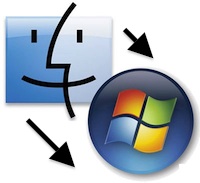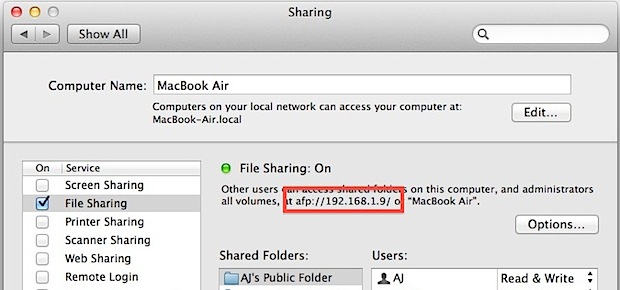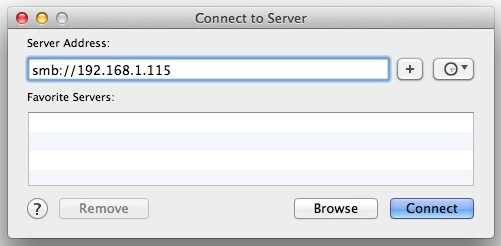Share Files from Mac OS X to Windows PC’s Easily
 If you have a mixed network of Mac and Windows PC’s, chances are good that you’ll be wanting to move files between the two operating systems. The easiest way to share files from Mac OS X to Windows is to enable Samba support for a given user account on the Mac. This tutorial will how to share files between Mac and Windows PC this way.
If you have a mixed network of Mac and Windows PC’s, chances are good that you’ll be wanting to move files between the two operating systems. The easiest way to share files from Mac OS X to Windows is to enable Samba support for a given user account on the Mac. This tutorial will how to share files between Mac and Windows PC this way.
Samba (SMB) may have a funny name but it’s essentially just Mac OS X to Windows file sharing support. Because it’s not required by all Mac users or for Mac-to-Mac sharing, it’s actually a separate unique sharing option within Mac OS X File Sharing panel, and enabling it allows a Windows PC to connect to the Mac without any additional software. Let’s cover exactly how to enable this feature, and then how to connect to a shared Mac from a networked Windows PC so that you can swap files back and forth with ease.
Enable Mac to Windows File Sharing in Mac OS X
First you need to enable the Windows to Mac file sharing functionality, this is a simple preference toggle in Mac OS system settings on the Mac:
- Launch “System Preferences” and click on “Sharing”
- Click the checkbox next to “File Sharing” to enable it
- Once File Sharing is turned on, select it and then click on the “Options…” button
- Click the check box next to “Share files and folders using SMB (Windows)”
- Now click on the checkbox next to the user accounts you want to share or access from Windows – when you click to enable SMB sharing on a user account, you will be asked for that users password
- Click on “Done”

With SMB enabled, we now can connect from the Windows PC to the Mac. If you already know the Macs IP address you can skip this first part of this and go directly to the Windows PC to access the shared users directory.
Connect to the Mac File Share from a Windows PC
With SMB and Windows File Sharing enabled, you can now connect to the Mac from any Windows PC. First you’ll get the Macs IP address that you need to connect to, then you’ll connect to that from Windows:
- Back at the ‘Sharing” system preference panel, take note of your Macs IP address as seen below, discard the afp:// portion and pay attention to the numbers in the format of x.x.x.x
- From the Windows PC connecting to the Mac:
- Go to the Start menu and choose “Run” or hit Control+R from the Windows desktop
- Enter the IP address of the Mac in the format of \\192.168.1.9\ and choose “OK”
- Enter the shared Mac OS X users login and password and click on “OK”


Access to the shared Mac directory and user files appear as any other folder within Windows. You’re free to copy or access individual files, or perform more substantial tasks like moving an iTunes library from a Windows PC to a Mac.
This process of connecting to the Mac should be identical from Windows XP, Windows Vista, Windows 7, Windows 10, and Windows 8 or RT, and enabling file sharing on the Mac is the same in MacOS Catalina 10.15, MacOS Mojave 10.14, macOS High Sierra 10.13, macOS Sierra 10.12, Mac OS X 10.6 Snow Leopard, 10.7 Lion, 10.8 Mountain Lion, and OS X Mavericks 10.9, and El Capitan 10.11, OS X Yosemite 10.10.x. SAMBA has been a supported Mac protocol for a very long time, so technically you will find that older Macs and OS X versions will also be supported by this.
Connecting to a Windows PC from a Mac
Going the other direction, you can connect to a Windows Shared PC very easily from a Mac running Mac OS X:
- From the Mac OS X Finder, hit Command+K to summon “Connect To Server”
- Choose the “Browse” button to browse the available network shares, double-clicking on the share to enter a login
- OR: In the “Server Address” field, simply enter the IP of the Windows share to connect to preceded by smb://

For example, to connect to a Windows share at 192.168.1.115, the smb address would be: smb://192.168.1.115
Note that an issue with some versions of Mac OS X Mavericks causes smb:// to use Samba2 rather than Samba1, which may cause connection errors with some servers. If you run into such a problem connecting to a NAS or SMB Windows share from OS X 10.9 Mavericks, you can forcibly use Samba1 with the cifs:// prefix like so: cifs://192.168.1.115 – this is not the case with Mac OS X Yosemite or other versions of MacOS and Mac OS X.
What about the .DS_Store files?
Depending on the Windows PC settings, you might see a bunch of .DS_Store files on the Mac file system. These are normal but if you’re peeved by them, you can disable .DS_Store files by entering the following defaults write command in Mac OS X’s Terminal:
defaults write com.apple.desktopservices DSDontWriteNetworkStores true
If you want them back, just switch that to ‘false’ at the end.


This works great, lol, 10+ years after the fact… just saved my rear. thanks!
Indeed SMB still works great, there is no better direct way to network and share files between a Mac and PC.
Glad it helped you!
I know this is an old post but it was a life saver! My beautiful 17” MBP died after 10 years and I’m forced to use the PC. Blech. I was able to connect to my baby MBP to access my external hard drives using this method. Another reason why I love my macs. They are so easy to get along with. Thanks again.
Kim, I hear you about PC… Blech. I’m still on my beloved Snow Leopard, but finding it impossible to log into my PC running Windows 10 Home to transfer files. The reason why I do not venture beyond Snow Leopard is because I do not wish to rebuy all my software that no longer run beyond OS10.6.8. In fact, much of it is not longer offered anymore. Great, huh? Mac, it just doesn’t work.
Just some notes about lessons I learned spending endless hours trying to figure this stuff out:
First important lesson:
– Mac OS and Windows do not automatically see/recognize each other via ANY network lists, whereas by default Windows will see other Windows computers and Mac will see other Mac computers automatically.
(if anyone else knows of a way to make this auto-discovery work across platforms, please share).
Second big lesson, there are 2 DIFFERENT SYNTAXES used:
– EITHER \\IP address OR \\NetBIOS Name
– OR smb://IP OR smb://NetBios name
Note carefully the backslash vs forward slashes.
If one does not work, try the other. In all cases I have tried, when you use the explicit syntax wherever access to a Network drive is required, it should work.
BIG TIP: avoid using IP addresses. This way you can save the link to computer or folder and no not have to remember or adjust your links if/when the IP address changes by the router (unless you purposefully use Static IP addresses).
All the above works from Mac OS 10.6 to 10.12 (so far), and Windows 7 to 10 (so far); may work for older versions too.
HTH
OMG. spent hours trying to map a damn smb share residing on my mac, from my pc. literally everything in mac/windows support/forums says syntax is “\\smb:x.x.x.x\”. all I did was take out “smb:” and was able to connect. The crazy thing is that I cannot even ping the smb @ 192.168.1.109 buuut wtf i, ON TH share. regardless, this article showed not to use “smb:”. Thanks.
I’ve been trying to connect to a shared folder on my Mac Mini (running OS X EL Capitan) from my Windows laptop (running XP). I can ping the Mac but I cannot connect to it. I’ve set up the sharing on the Mac exactly as outlined, using the SMB option.
Thoughts?
Thanks!
Doesn’t work at all with windows 10 and mac osx el capitan.
This works flawlessly to share files between OS X EL Capitan 10.11 and later, with Windows 10 on any PC. I use it all the time. Thanks!
If you are not following the instructions you can’t share the files. Mac to Windows, easy.
I have Mavericks 10.9.5 trying to connect to a XP SP2 computer. My Macbook pro could see the shared device but not connect. I tried RDC 2.01 but that failed also. The XP computer had been on a Windows Domain so I changed it to a Workgroup with an 8 Alpha Character name. After a reboot I was able to see the shared drives and copy files to my Mac NAS device.
I tried connecting to Win 7 PC from Mac OS X 10.9 but cannot establish connection (connection failed).What should I do?:-(
On Mac OS 10.5, I dont have to check the “on” box next to the account for an SMB public share to be accessible over the LAN… but in Mavericks, it does not work either way: I can connect to an AFP share on Mavericks from a machine running Leopard, but I cannot connect to an SMB share on Mavericks from a Mac, or from an SMB client on Android, or an SMB client on my networked Blu-ray player. Mavericks is just focking broken. If it works with Windows, that must be the ONLY thing it works with.
This is a great tip! I remembered having some difficulties with SL to Vista. But Mavericks and Windows works awesome and flawless!
Thank you for the tutorial!
[…] this uses iMessage, recipients in the PC world will not be able to get the file, you would need to use standard Windows file sharing instead. But for any receiver who is in the world of Apple, this is a great way to bulk send a […]
I made it all the way to this point:
<>
Windows XP is asking for me to enter “DOMAIN/username”
What’s the domain? It’s automatically entering something that isn’t working and I don’t think it’s correct. Ugh!
In Windows
Enter \your mac username
Then enter mac password
You mac is probably not on a domain but on a workgroup so \ will be fine.
I’m having the same problem as Julia. I don’t get to enter my username; it’s pre-formed for me in the dialog box that asks for the password.
Also, in my sharing preferences, my Mac’s IP address doesn’t show up, just the Mac’s name, and a long (meaningless) string.
Can anyone help i’ve been trying to do this but only on a bluetooth connection, my pc can already access the shared folder but can overwrite the file. it just keeps copying the file on my mac and cannot update the document to update the one on my mac. is there a way for the pc to be able to update the file from its end?
this working for me for few day, after i restart the Mac, window 7 no longer able to view the file. keep asking for the user name and password. try three different computer, got a same problem. please help~~~
Same problem here, get an error saying that the path may not be correct
after i typed in run box it showin error that the network path is not found… :( :( can anyone plz reply to me soon
i replaced my computer name (in the picture above says “Macbook Air”) by may IP address and it started working again.
So to follow the example above, instead of using Macbook Air as the name of the computer just use “smb://192.168.1.9” of course you will be using your own ip address but use the “smb://” anyway.
I hope this helps
I have been having a nightmare trying to link my Lion OSX 10.7 with Win XP. I can see the windows files and folders no problem from the MacBook Pro, but i keep getting the message that ‘ macbook is not accessible. You might not have permission to use this network resource’ I have followed all of the instructions (file sharing enabled, SMb etc etc) have even tried it with firewall turned off and still it will not let me connect to MacBook. PLEASE, PLEASE someone help me as this is driving me crazy. PS I am new to Macs and Networking……in case you hadn’t guessed!
Like Marshal, I am facing the same problem and not found any solution. Using Mac with Lion OS and Windows XP. I am using same login name on both machines. Able to see the shared folders on the Windows machine but not able to go into them. HELP!
From Windows, I am able to read the shared Mac folders and even write to them. BUT not a shared exFAT partition on the Mac. It is visible but not accessible. HELP!
[…] will even work for someone connecting to a shared Mac from a PC, the only requirement is a valid Apple ID, either from iTunes, the App Store, or from elsewhere in […]
hey, I’ve followed all these steps, but it does not ask me for a username, just pops up with a blank explorer window connected to the IP adress, been trying to trouble shoot this for ever… Any help would be apprechiated
I have been using this method for many years, most recently with a new 10.7 server I put in last fall. It was working in December.
Now, however, perhaps after the Microsoft security update yesterday, it does not work from Vista, XP or 7.
Something has changed, but it doesn’t seem to be anything we’ve done at this end…
Anybody have any ideas?
Hi There
I have been trying to setup today a File Server using one of my Mac Pros. I have tried Panther, Leopard and Lion (and server) and I hit a problem with all regarding file permissions. When I setup a shared directory with Everyone with Read/Write permissions (and also added the Network users as this is on a windows domain) and a user copies a file to the OS X Share the file or directory copied across permissions change to that user so others can’t access – defeating the purpose of being a file server. Any clues of how to solve – I have searched the internet for an answer.
Paul
looks like this is a fix for Chuck and me:
http://alan.lamielle.net/2009/09/03/windows-7-nonpaged-pool-srv-error-2017
Having the same problem as Chuck. Large files or large amount of smaller files trying to copy to a Windows share and get the same error.
For the longest time, however, sharing / mounting a Windows share on a Mac has been completely messy. I’m about to upgrade to Lion and I anticipate nothing will have changed.
Here’s the problem: mount a Windows shared folder on your Mac. Grab some large files and copy to that Windows folder. If the files are too large — I don’t know the limit but perhaps a group of them 200mb each — OSX gives you an “insufficient” error and stops the copy. After that, you can’t mount the volume unless you restart the Mac.
Anyone seen this?
Hi!
I can view the mac in “workgroup computers” of my pc but i cannot view the shared folders in it. i keep on entering the user name and password of the account that i created in my mac.
Hope you could help me. TIA.
Works fine between Lion and XP – watch the switch from forward to backward slashes though when entering the IP address.
Seems like a lot of work, just use [cough] Dropbox [cough].
i mean “write a review”
hey, Safari for Windows has a new update, can somebody read a review about it!
And guess what, the Reading Pane is now available!! \m/
This works perfect with my OS X Lion & Windows 7 machines.
Yeah but be warned!!!!
Lion (10.7) won’t let you share either via AFP or SMB if your discs are not formated in “Mac OS Extended” not “MS-DOS” or “NTFS” etc… so look out for your shared pendrives etc….
You can always read the drive to copy files from it, but writing to NTFS is not supported
On the Windows side, I highly recommend mapping a network drive so that you can access the Mac without having to reenter the IP and credentials on each connection. Will save you a lot of time very quickly, plus it’s accessible from Explorer and file open/save menus.
[…] Share files from a Mac to Windows PC – covers enabling file sharing on the Mac and then connecting to the Mac from a Windows PC. Works with OS X 10.6 and 10.7 and Windows Xp, Vista, 7. […]